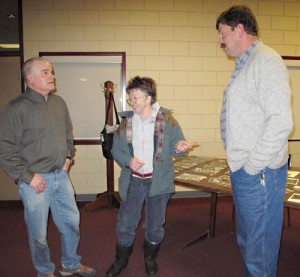
By Laura Stovel
In the epic annual journeys of migratory birds, resting places can be few and far between. For those requiring marshes or wetlands, the distance between stops may be hundreds of kilometers. The marshes around Revelstoke provide some of those stops for many species of migratory birds, said environmentalist and bird habitat researcher, Francis Maltby who was guest speaker at a North Columbia Environmental Society member’s night on Wednesday.
Between Valemount, around 250 kms to the north, and Kootenay Lake, about 100 kms south, the Revelstoke area hosts four marshes suitable for migratory water birds to land and feed: Downie Marsh in the Greenbelt area, Airport Wetlands, and Cartier Marsh and Montana Slough south of town.
In a 2004 article for Parks Canada, Michael Morris wrote that before Europeans settled this area the land south of Revelstoke was “a mosaic of sloughs, willows, cottonwood and cedar trees.” Farming activity, and later the flooding of the Arrow Lakes Reservoir in 1968 when the Keenleyside Dam was built, destroyed much of this habitat. According to Morris, 65 species of birds feed in the Revelstoke wetlands and “the area by the airport is the best remaining fragment of habitat in the three reservoirs on the Canadian portion of the Columbia River.”
Human activity harms habitat, but it also creates new opportunities. Maltby observed that two important existing wetlands, Downie Marsh and Airport Wetlands, are man-made. The Airport Wetlands were created when dirt was dug up to build the airport runway and water filled those holes. Similarly the ponds of Downie Marsh emerged from the craters left when the Downie lumberyard was built.
The main focus of Maltby’s talk was the Downie Marsh, which is easily accessible from the parking lot near the baseball diamonds. Thirty years ago, when Maltby first arrived in Revelstoke, birds covered the entire area of Downie Marsh, he said. With the construction of the Greenbelt trail and increased recreational activity in the nearby grasslands, the number of migratory birds feeding in the area has greatly decreased.
Increased human and dog activity around wetland areas increases the stress level of birds, Maltby said.
This may not only result in fewer birds landing in these areas, but also less feeding activity by those who do land. “Not all birds respond (to human activity) the same way,” he said. Some, like dippers and wigeons, are not as sensitive to human activity as others, like great blue herons.
Maltby described walking on the Greenbelt trail about 100 meters from a great blue heron. He stopped and watched the bird for a long time, and the heron watched him. “If they are watching you, they’re not feeding,” he said. So they are not making productive use of the time that they are resting because they are afraid or stressed.
Maltby was not arguing against recreational use of the Greenbelt area near Downie Marsh, but rather for more conscious use. As a rule, try to stay 100 to 150 meters away from wetlands, he said. If that is not possible, “try to stay invisible.” For this reason, trees have been planted near the ponds on the Downie Marsh to make humans and dogs less visible to the birds. “If there is a visual buffer,” he said, “there is a greater chance to have that heron relaxed and feeding.” Recreationists should also avoid making noise, walking near the ponds or allowing their dogs to approach the water.
In his presentation, Maltby displayed a map showing his suggestions for recreational activity in the Downie Marsh. This provides a compromise between the needs of recreationists and the needs of birds. The area marked in green is suitable for sensitive recreational use, the area marked in red is particularly sensitive and should be avoided, and the area marked in yellow provides supporting habitat for birds who may not enter the marshes themselves. This area should be avoided, especially during spring and fall when birds are migrating. Click here to view Maltby’s map



